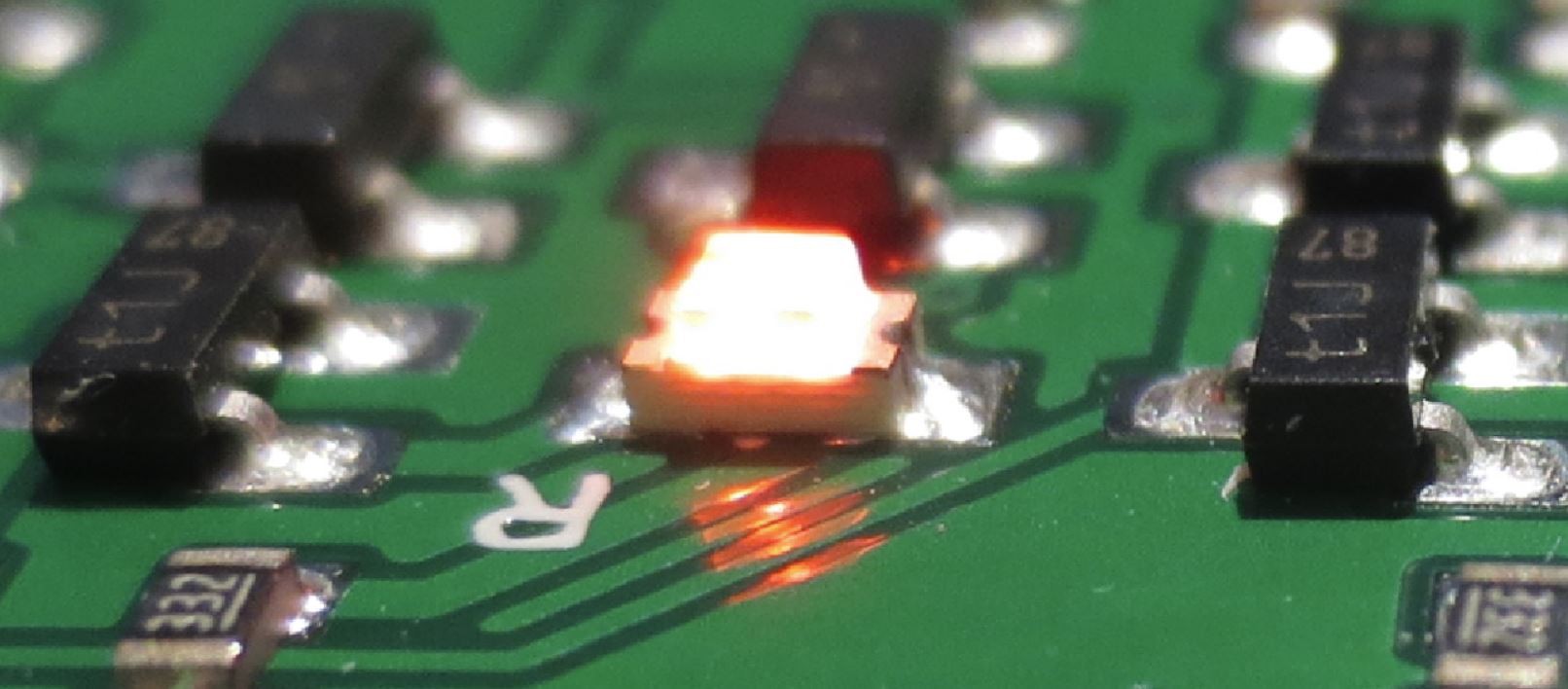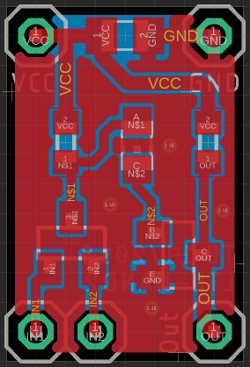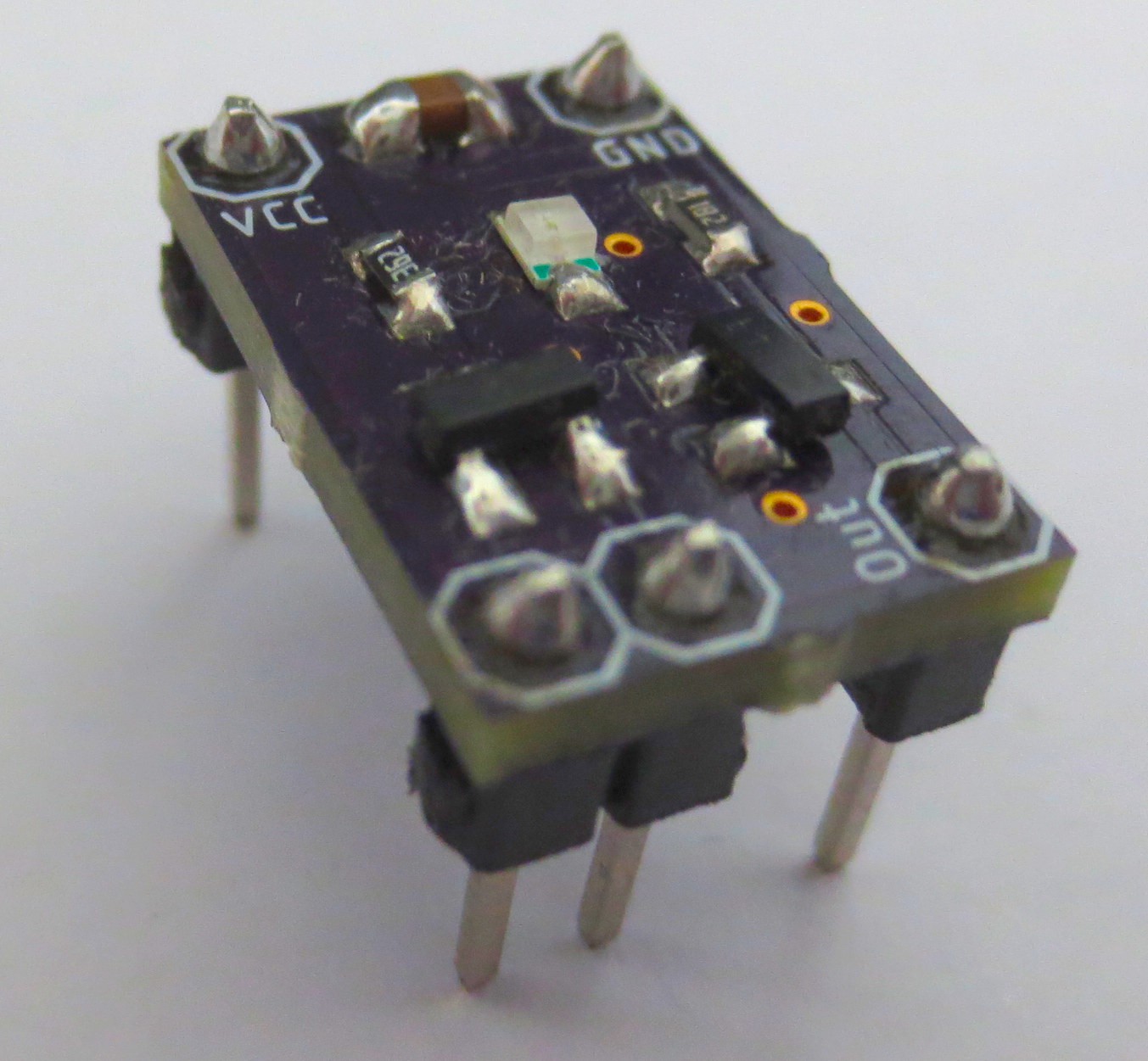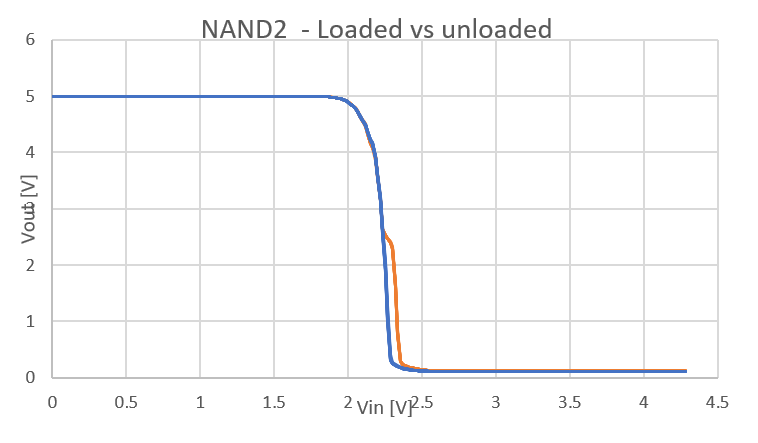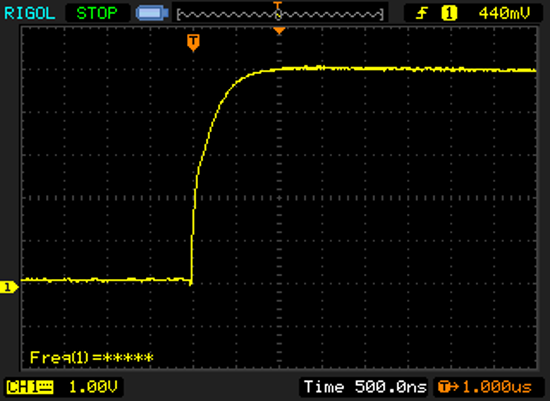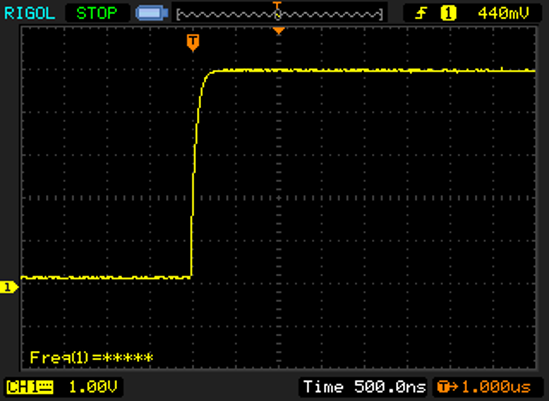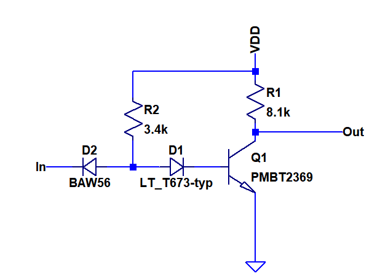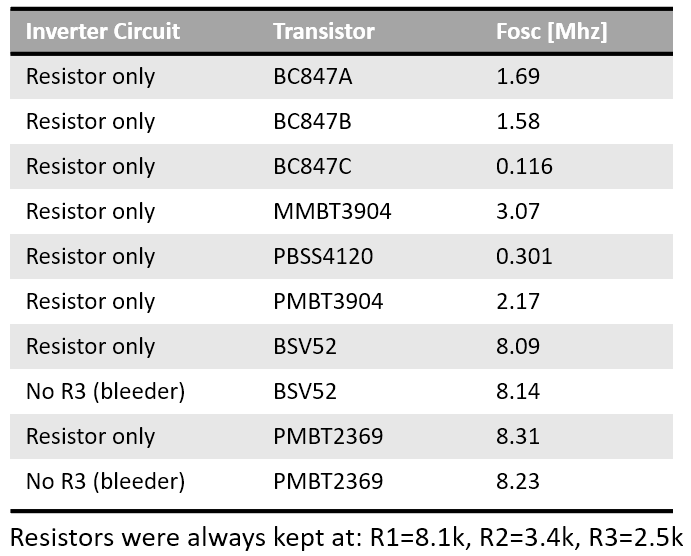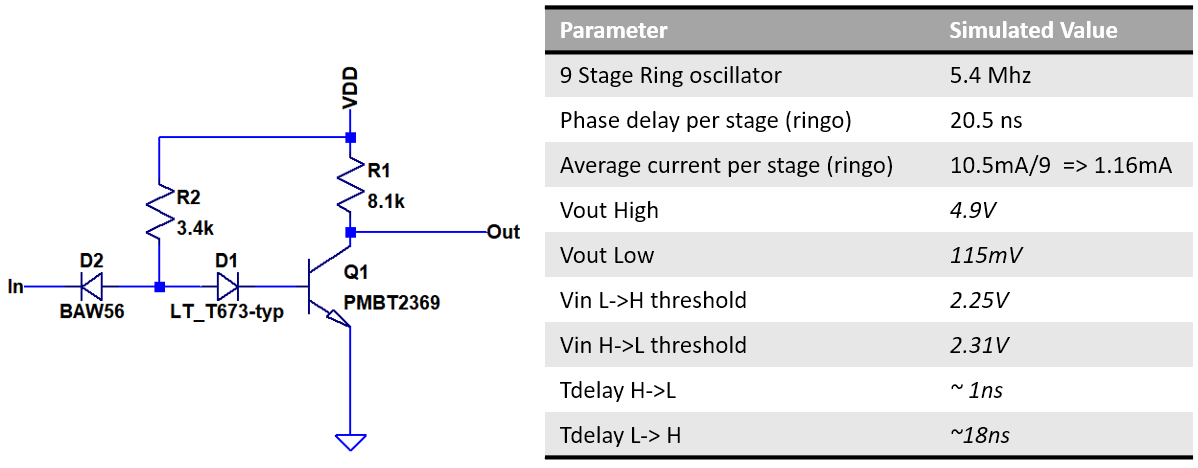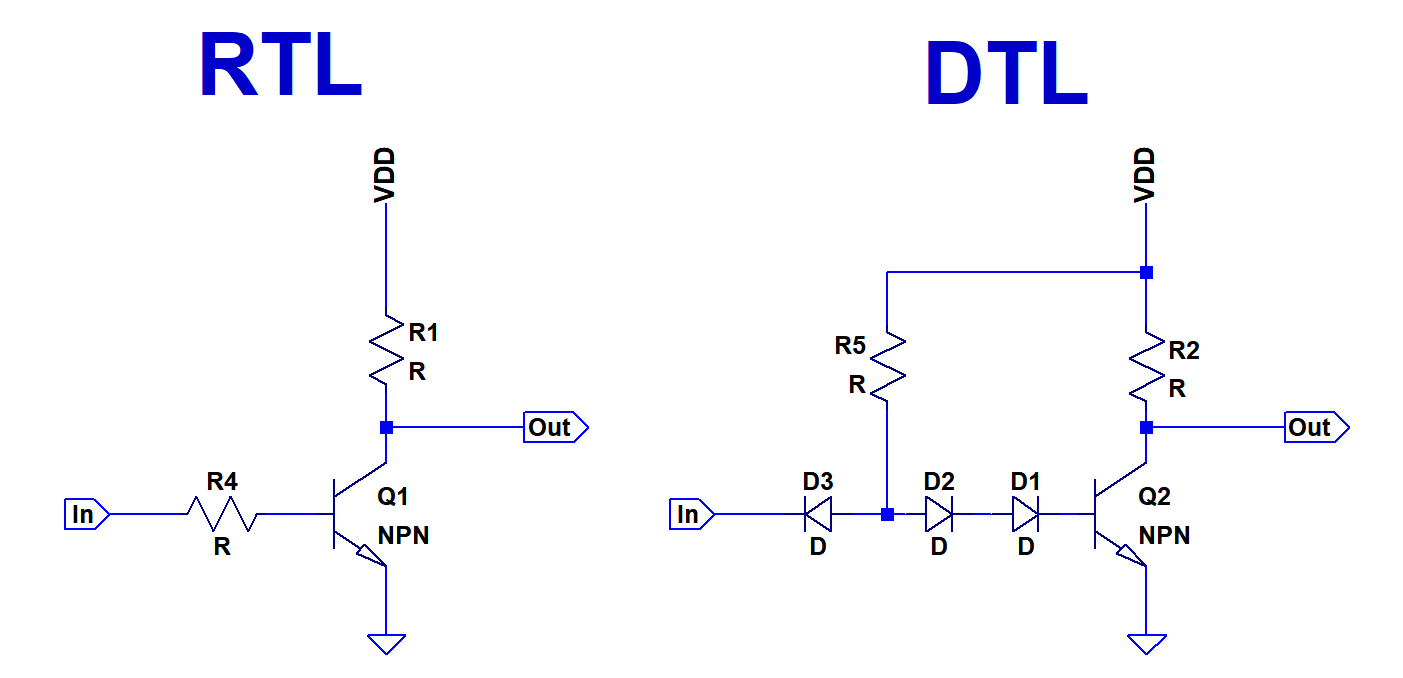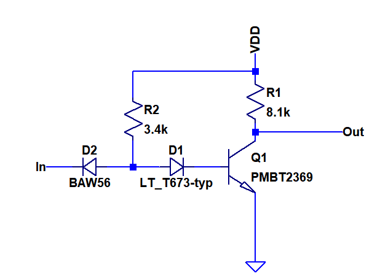-
XOR Gates
02/18/2020 at 21:07 • 1 commentAs a next step we will look into options to design XOR2 gates in LTL.
A straightforward approach is to build a XOR2 gate from 4 NAND gates. This is simple and robust, but results in a propagation delay of three NAND2 equivalent. Not perfect for fast circuits. Also, the component consumption is quite high.
Another option is to use an AOI2 gate and two inverters. The number of components is almost the same as the NAND2 implementation, but now the propagation delay is only two gates. Furthermore, often inverted signals are alrady available as output from a previous stage. In that case, the inverters can be omitted.
One approach that has been discussed at length at the hackaday TTLers is to use a cross coupled transitor pair, as shown above in a XNOR2 gate. This method is really tricky and drastically reduces the part count. In context of LTL there are a few challenges, though: The gate above is basically an RTL gate and will sink current when the input is high, which leads to a reduced fan-out. The threshold voltage is not defined relatively to ground, but in reference to the second input. The gate switches when the voltage difference between both inputs is equal to Vbe (~0.7V) - very different from the normal LTL threshold. Also, the output low level is 2xVCEsat instead of 1xVCEsat. The combination of all these effects leads to some headaches when designing circuits with several of these XNOR2 gates as they will start to influence each other and the noise margin degrades. A few changes have to be introduced to make this type of gate a bit more compatible to LTL.
An LTL version of a XOR2 gate based on a cross coupled transistor pair is shown above. First, this device has an output inverter to restore the low level. An input diode and resistor is added to avoid current sinking during high. To fix the threshold levels, two additional diodes were added (D1, D3). LEDs cannot be used in this place, because there are other elements in the current path (D1,D2, output transistor from preceding gate) that add to threshold voltage. The threshold level is still defined by the differential voltage between two inputs. This is still of concern, but a little less relevant now since the output levels have been restored. Assuming the input low level is 1xVCEsat, the threshold level is equal to VD1-VD3+VBE+D2+VCESat: 0.7+0.7+0.2 ~ 1.6V. This is much higher than the 0.7V of the bare transistor, however still not the same as the LTL threshold levels.
The three options are summarized above. Using a 3T XOR2 gate allows to reduce compenent count drastically, but still comes with some potential to screw up signal integrity. In practice often both inverted and noninverted input signals are available. In that case using an AOI2 gate is the most straightforward option and only adds 9 components.
-
Basic Gates in LTL
02/16/2020 at 19:09 • 0 commentsAfter successful validation of the LTL concept in real hardware I started to build up a library of common gates in LTspice as a foundation for the design of a CPU.
The basic gate of LTL is the NAND2 gate. Symbol and circuit shown above. In my final design I used gates with different threshold level so I added a "G" to a high threshold device with a green LED.
![]()
Every gate was tested in a simple testbench in LTspice. I arbitrarily chose a fan out (FO) of 7 for the test case, although this does not occur in the real design.
![]()
Test waveforms for the NAND2 gate are shown above - nothing peculiar. There is a little crosstalk between the inputs of the gates if one input is high and the other one is pulled low. This is due to the extremely high slew-rate of the falling edge on the output. In a physical implementation this will hopefully be reduced a bit by additional parasitic capacitances to the power plane.
Next is the NOR2 gate. This can be easily realized by a wired AND of two LTL inverters. A minor but very important detail: If a gate uses a wired AND at the output, neither of the LEDs will be representative of the output signal. In practice this means that additonal indicator-LEDs may have to be added to monitor certain nodes.
Last one is the AOI2 gate (AND OR INVERT). You may not be familiar with this kind of gate, but it is a very useful building block due to it's simple implementation. For example, it can be used as a multiplexer or as part of an ALU.
Finally, a list of part counts for each gate. Since my intention is to build a CPU with a minimal amount of discretes, it is important to keep track of this.
Not too exciting, so let's get to the more special building blocks next...
-
Characterizing LTL ring oscillators
02/15/2020 at 17:33 • 0 comments![]()
After characterizing a basic NAND2 gate, the next step is to measure the timing properties of the LTL gate. For this purpose I built a ring oscillator based on five gates. The PCB design is shown above. I added one additional inverter as an output buffer to avoid loading of the oscillator while measuring its frequency.
I built two versions of the ring oscillator: One with red LED and one with green LED, both using 1.8k collector resistors.![]() The scope screenshot shows the input (yellow) and output (turquoise) waveform of one inverter in the ring oscillator (green led). The falling edge is steep since it is actively pulled down by the transistor. The rising edge is, again, separated into two regions depending on wether only collector resistor or base and collector resistor are involved in pulling up the node.
The scope screenshot shows the input (yellow) and output (turquoise) waveform of one inverter in the ring oscillator (green led). The falling edge is steep since it is actively pulled down by the transistor. The rising edge is, again, separated into two regions depending on wether only collector resistor or base and collector resistor are involved in pulling up the node.![]()
The diagram above shows measurements of ring oscillator frequencies versus supply voltages. The blue line corresponds to the inverter with green LED, the orange line to a red LED. There is a clear trend towards higher frequency for higher supply, which can be explained by the availability of more switching current. The red LED LTL gate has a lower threshold voltage and does therefore switch earlier and faster. Since this design is based on the PMBT2369 switching transistors, no dominant influence of base saturation is observered. LTL gates with normal small signal transistores should exhibit a speed-supply relationship similar to what I observed with RTL.The supply current shows a linear relationship with supply voltage, as expected for a resistor-loaded gate.
The table above summarizes the charactization of the LTL gates. There is a tradeoff between high noise margin (green LED) and speed (red LED). All in all, the propagation delay looks very acceptable for discrete logic. At tp=6.9ns, the red LTL gate is almost as fast as the RTL gate in a CDC6600 and still much faster than the BC847 based DTL gates used in the MT-15, while maintaining full 5V CMOS/TTL logic level compatibility.
Did I mention that each gate comes with its own blinkenlight? -
Characterizing a NAND2 gate
02/15/2020 at 16:03 • 0 comments![]()
I designed a neat breadboardable LTL-NAND2 gate to test the design in hardware. You can find the PCB layout and a photo of the finished product above. I use a BAW56 dual-diode in a SOT23 package for the input diode. This form factor is much easier to handle than single diode SMD packages and there is no cost disadvantage. You can see the LED in the center of the PCB. I made a few variation with different LEDs: green (high Vf) and red (lower Vf) and different collector resistors.
![]()
Transfer characteristics were measured by using the DAC and ADC of an ATtiny416. You can see that different LEDs can be used to adjust the threshold levels of the NAND2 gate. Red with a low forward voltage leads to a L->H threshold around 1.65 V while green as it 2.24/2.33V depending on collector resistor.
![]()
To build up more complex circuits it is also important to study the effect of output loading. The figure above shows the NAND2 gate with floating output and with another NAND2 gate connected to it. The threshold is slightly shifted for the loaded output, but not to a level of concern.
![]()
The scope picture above shows the transient switching behavior of a loaded NAND2 output with green LED and 8.2k collector resistor. One can see that there are actually two elements to the rising edge. Initially, the voltage rises quickly and is then followed be a slower slope. During the initial part, the 3.4k base resistor of the connected gate helps pulling up the output. However, after the threshold voltage is reached, the current from the base transistor flows into the base of the transistor and the output is only pulled up by the 8.2k collector resistor.
![]()
The behavior of the NAND2 gate with 1.8k collector resistor, as shown above, is more consistent and shows a fast rising edge up to Vhigh. I therefore decided to focus on using 1.8k as a collector resistor.
-
Optimizing the LTL gate
02/15/2020 at 10:42 • 0 comments![]()
Replacing the base diodes in an DTL gate with an LED saves one component. One very interesting side effect is that the LED also emits light. Modern LEDs are already quite bright at around 1mA of current, so the normal base current will be sufficient to turn it on.
But what is the impact on the circuit behavior? Usually we would like to use fast switching diodes for any logic circuit. Switching diodes are optimized for low capacitance and low recovery time to be able to switch very fast between forward and reverse operation. Here I am using a BAW56 dual diode, which has a capacitance of 2pF and 6ns reverse recovery time, as the input diode. LEDs are not optimized for switching operation. They typically have a fairly high capacitance of around ~40pF and take long time to be switched off. Therefore, using an LED in place of D2, the input diode, would slow down the gate significantly.
The base diode is, however, never in reverse operation. Therefore the bad switching properties of the LED are not an issue. In addition, the higher capacitance helps to pull down the base potential quicker if the transistor is to be turned off. You sometimes see intentional reach-through capacitors in parallel to the base diode in DTL gates.
Some attention has to be paid to the terminal between D1 and Q1 base. If the transistor is turned off, this terminal is pulled to negative voltage and is basically floating, since the base-emitter diode is reverse biased. I found that this can lead to a shift of switching voltage depending on duty cycle and frequency of the incoming signal. It may be advised to use a bleeder resistor to conntect this node to the ground. Due to simplicity, I omitted this and made sure to design glitch free logic instead...
I spent quite some time optimizing the basic gate in LTspice. To measure switching speed, I simulated a 5 stage ring oscillator. One crucial choice was to pick the right transistor, as I also outlined in greater detail here.
You can see simulation results for several different configurations above. I also tried various configurations with reach through caps and baker clamps but found that chosing the right transistor, the PMBT2369, yielded much better results that all other options. The PMBT2369 is available in a SOT23 SMD package for around $0.02, so there is really no reason to use the BC847 or MMBT3904 over it.
![]()
Final parameters of the simulated inverter are shown above. The relatively high L->H delay is owed to the use of a relatively large collector resistor. Note that the threshold voltages are almost centered between the 5V supply and ground, maximizing noise marging and making the gate compatible to CMOS logic levels.
-
RTL vs. DTL vs. LTL
02/14/2020 at 14:55 • 0 commentsRTL versus DTL
Both RTL (Resistor Transistor Logic) and DTL (Diode Transistor Logic) were common logic families in the early days of transistors. The image above shows inverters in both logic families.
RTL is the simpler of the two, but it suffers from many issues: The L->H threshold is defined by the forward voltage of the base-emitter junction of the transistor and is hence rather low, around 600mV for a typical silicon transistor. Furthermore, if the input is at high level it will sink current which is supplied by the collector resistor of the preceding gate. To maintain consistent logic levels it is therefore necessary to adjust all resistors according to fan-out. Besides that, there is also a lot of nastiness in dynamic operation.
DTL addresses these shortcoming by introducing additional diodes: When the input is high, all the base current will be supplied by the base resistor (R5) and there is no current flowing into the gate. When the input is low, current is sourced from the gate, which is sunk into the transistor of the preceding gate. Since the transistor is fairly low-ohmic when it is turned on, there is much less limitation in fan-out. Furthermore, it is not necessary to adjust gate resistors depending on fan-out. This allows using the same resistor values throughout the entire circuit.
A second improvment in DTL is to lift the L->H threshold to a higher voltage. It is now defined by Vbe+Vd2+Vd1-Vd3, which is roughly 1.3V depending on the compenents used.
From DTL to LTL
![]()
The image above shows the circuit of an LTL inverter. At the first glance it looks very straightforward: We replace the two silicon diodes with a LED. Since the LED has a much higher forward voltage (depending on LED type), only a single diode is sufficient. This is nice, because it saves one component, but is it actually a good idea?
LCPU - A CPU in LED-Transistor-Logic (LTL)
This projects tracks my efforts to develop discrete LED-Transistor logic building blocks and designing a CPU from them.
 Tim
Tim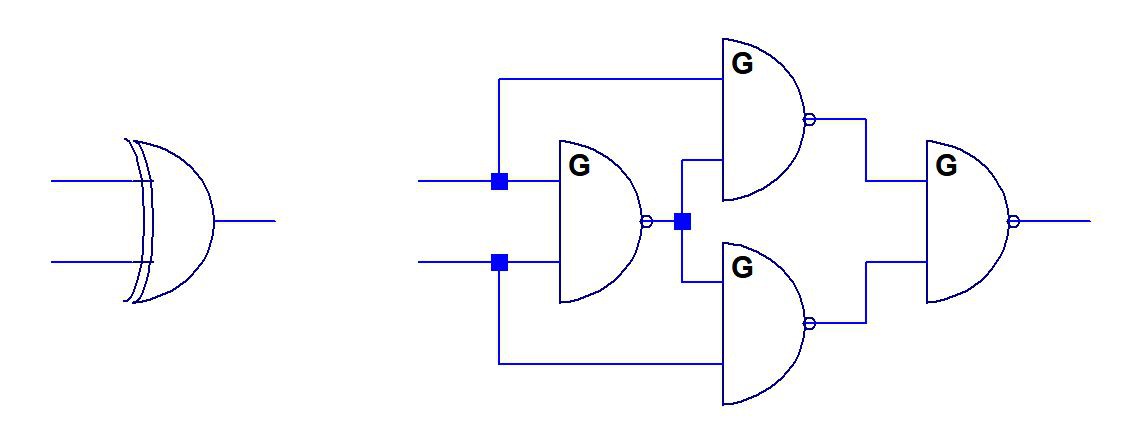 A straightforward approach is to build a XOR2 gate from 4 NAND gates. This is simple and robust, but results in a propagation delay of three NAND2 equivalent. Not perfect for fast circuits. Also, the component consumption is quite high.
A straightforward approach is to build a XOR2 gate from 4 NAND gates. This is simple and robust, but results in a propagation delay of three NAND2 equivalent. Not perfect for fast circuits. Also, the component consumption is quite high.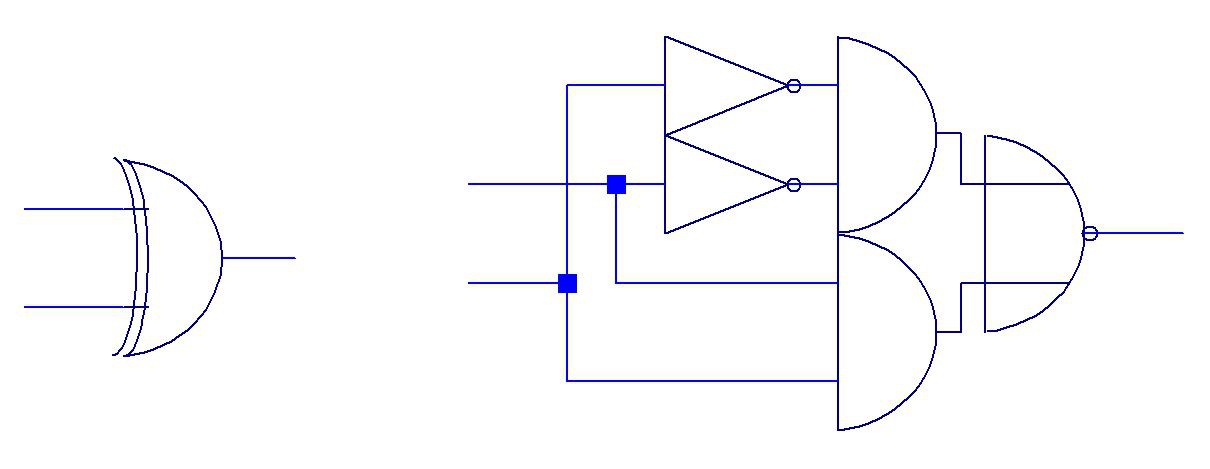
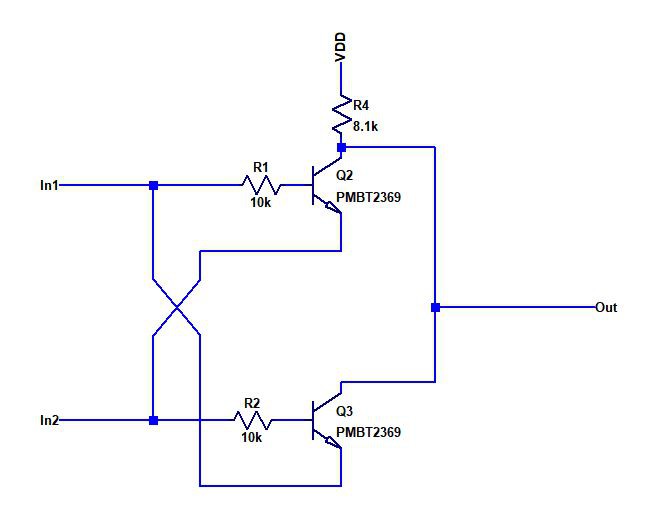 One approach that has been
One approach that has been 
 The three options are summarized above. Using a 3T XOR2 gate allows to reduce compenent count drastically, but still comes with some potential to screw up signal integrity. In practice often both inverted and noninverted input signals are available. In that case using an AOI2 gate is the most straightforward option and only adds 9 components.
The three options are summarized above. Using a 3T XOR2 gate allows to reduce compenent count drastically, but still comes with some potential to screw up signal integrity. In practice often both inverted and noninverted input signals are available. In that case using an AOI2 gate is the most straightforward option and only adds 9 components.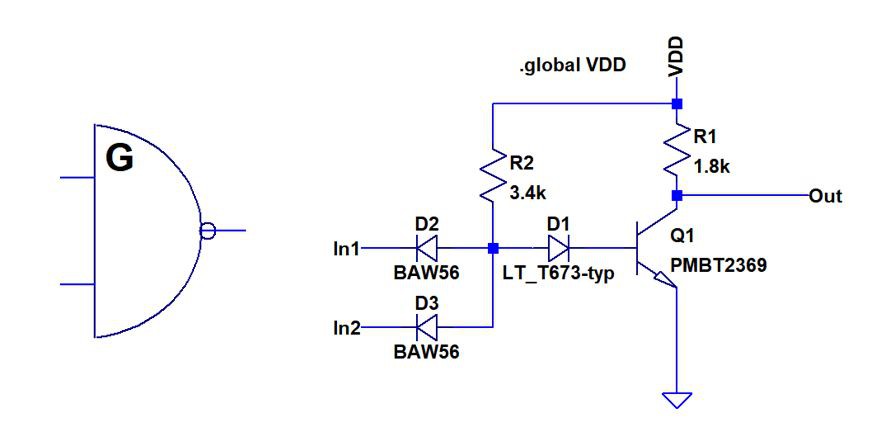
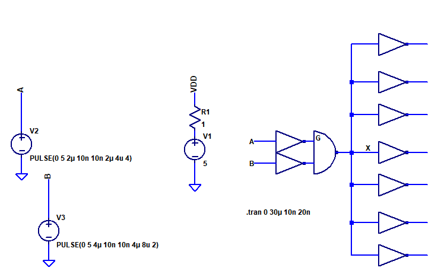
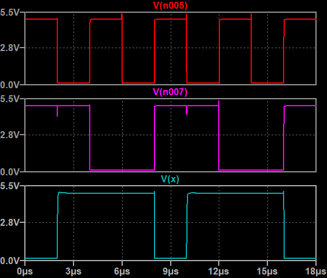
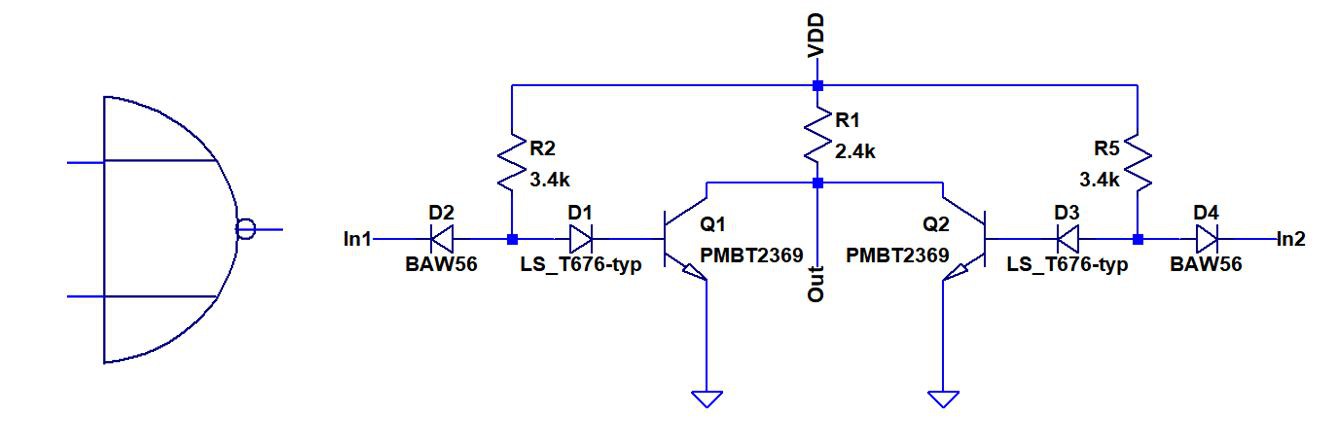



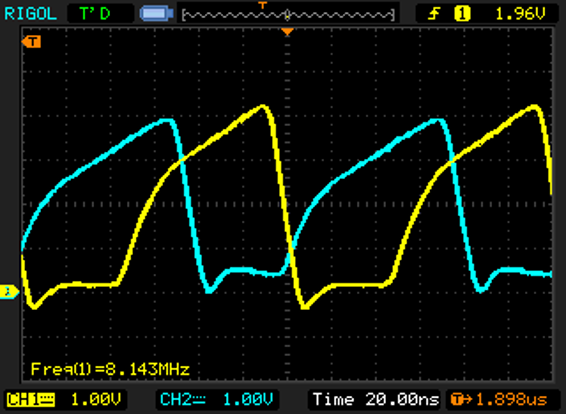 The scope screenshot shows the input (yellow) and output (turquoise) waveform of one inverter in the ring oscillator (green led). The falling edge is steep since it is actively pulled down by the transistor. The rising edge is, again, separated into two regions depending on wether only collector resistor or base and collector resistor are involved in pulling up the node.
The scope screenshot shows the input (yellow) and output (turquoise) waveform of one inverter in the ring oscillator (green led). The falling edge is steep since it is actively pulled down by the transistor. The rising edge is, again, separated into two regions depending on wether only collector resistor or base and collector resistor are involved in pulling up the node.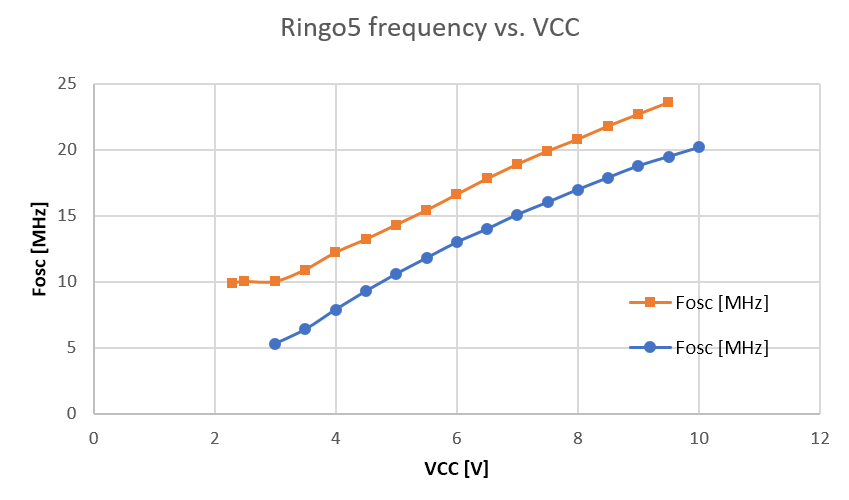
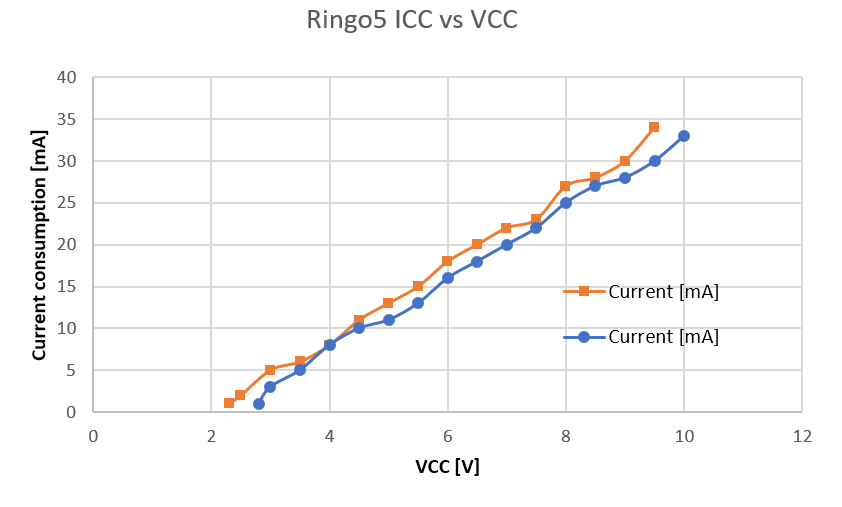 The supply current shows a linear relationship with supply voltage, as expected for a resistor-loaded gate.
The supply current shows a linear relationship with supply voltage, as expected for a resistor-loaded gate.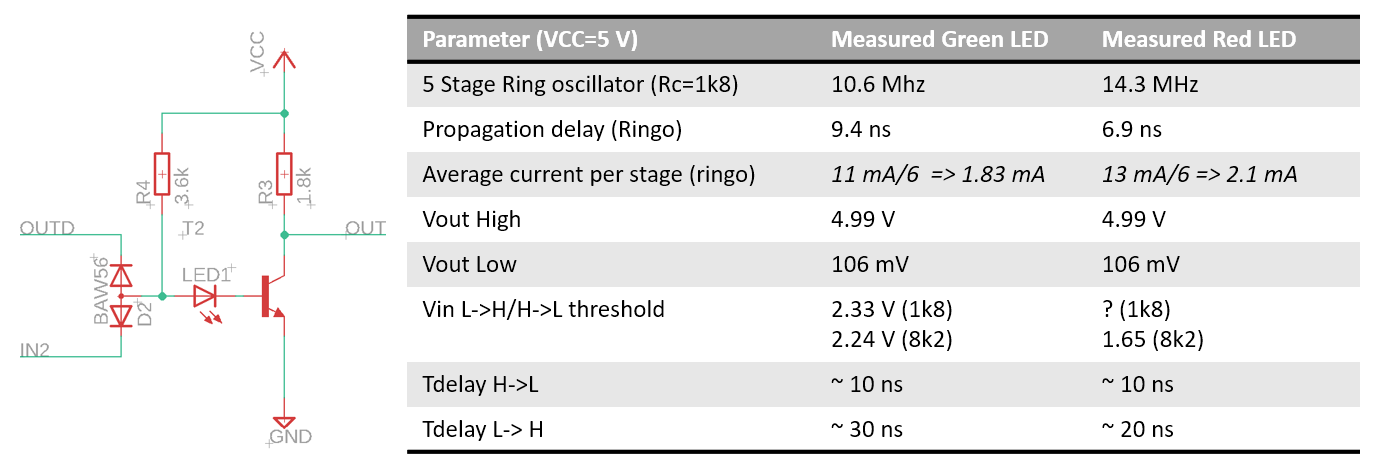 The table above summarizes the charactization of the LTL gates. There is a tradeoff between high noise margin (green LED) and speed (red LED). All in all, the propagation delay looks very acceptable for discrete logic. At tp=6.9ns, the red LTL gate is almost as fast as the
The table above summarizes the charactization of the LTL gates. There is a tradeoff between high noise margin (green LED) and speed (red LED). All in all, the propagation delay looks very acceptable for discrete logic. At tp=6.9ns, the red LTL gate is almost as fast as the 